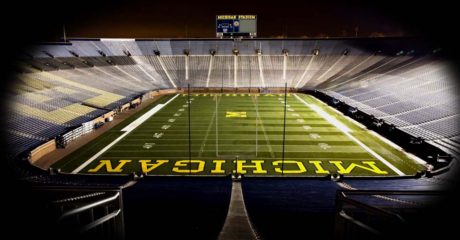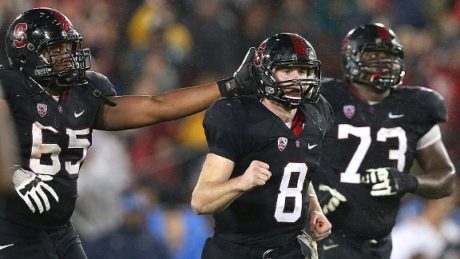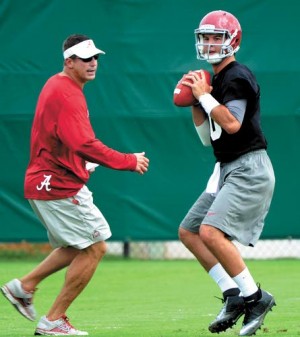Mailbag: Two quarterbacks a year?
 |
| Kevin Hogan |
Numerous people have been asking about Jim Harbaugh’s “standard” practice of taking two quarterbacks in each class. At Stanford he took 2, 1, 2, and 3 quarterbacks during his four years there, so it averaged out to two per year. Without getting into actual quarterback performance (which has been pretty good), here’s how the position has fared over the years. I used Rivals ratings since 247 Sports Composite ranking doesn’t work for ye olden days.
2006*
Alex Loukas (3-star): Redshirted in 2006. Backup quarterback in 2007, 2008, 2009. Moved to safety in 2010.
2007
L.D. Crow (3-star): Crow sat on the bench in 2007 and 2008. Transferred to UCF, so he sat out 2009. Third-stringer in 2010.
Kellen Kiilsgaard (4-star): Kiilsgard immediately became a safety in 2007 when he realized he had a better shot to play on defense. Spent one year on the team before quitting in favor of a baseball career.
2008
Andrew Luck (4-star): Redshirted in 2008, then became starter for 2009, 2010, and 2011 seasons. Became #1 overall draft pick in 2012.
2009
Taysom Hill (3-star): Signed with Stanford out of high school. Went on his Mormon mission and ended up at BYU when he returned. Backup in 2012, starter for Cougars in 2013 and 2014.
Josh Nunes (3-star): Other than part-time starting gig in 2012 trying to replace Andrew Luck, spent rest of time on the bench. Medically retired before 2013 season due to weightlifting injury.
2010
Darren Daniel (3-star): Sat on the bench in 2010. Moved to wide receiver in the spring of 2011, then transferred to Itawamba Community College, then to Alabama State.
Dallas Lloyd (3-star): Signed in 2010. Went on his Mormon mission and then returned to Stanford in 2012. Spent 2012 and 2013 as a backup quarterback. Moved to strong safety in 2014.
Brett Nottingham (4-star): Signed in 2010. Backup quarterback in 2011 and 2012. Lost quarterback job to Kevin Hogan, so Nottingham transferred to Columbia. Sat out most of 2013 with broken wrist. Started for Columbia in 2014 but got benched and then quit the team.
2011*
Evan Crower (3-star): Sat on bench in 2011 and 2012. Backup quarterback in 2013 and 2014. Potential for a return as a fifth year senior in 2015.
Kevin Hogan (4-star): Redshirted in 2011. Backup quarterback in 2012. Starter in 2013 and 2014. Will reportedly return as a fifth year senior in 2015.
STARTERS FOR STANFORD
2006: T.C. Ostrander/Trent Edwards
2007: T.C. Ostrander/Tavita Pritchard
2008: Tavita Pritchard
2009: Andrew Luck
2010: Andrew Luck
2011: Andrew Luck
2012: Josh Nunes/Kevin Hogan
2013: Kevin Hogan
2014: Kevin Hogan
2015: Kevin Hogan (probably)
CONCLUSIONS
As you can see, taking multiple quarterbacks per year did not affect Stanford negatively when it comes to scholarships. Of the eight quarterbacks Harbaugh signed during his tenure, only two (2!) spent four years at the quarterback position for the Cardinal. The rest of them transferred, changed positions, or quit football. Stanford also recruited a couple Mormon players who either never played for Stanford (Taysom Hill) or became a backup QB and then moved to defense (Dallas Lloyd). That situation may not arise for the Wolverines because the Big Ten imprint – Michigan’s primary recruiting grounds – does not have a huge Mormon population. Unless recruiting Mormons makes a drastic difference between the two schools, the numbers should not be an issue. Furthermore, that practice for Stanford led to a great three-year starter (Luck) and a solid almost-four-year starter (Hogan)
As for position changes, we’ll just have to see. Shane Morris has never played defense, although he probably has the speed to be some kind of safety. Wilton Speight has the size to move to tight end. Alex Malzone is too small and too slow to do anything else. Zach Gentry has the size and athleticism to become a tight end.
If Michigan continues to recruit two quarterbacks in each class, things will sort themselves out. Guys will quit, change positions, or transfer. In the meantime, Stanford has had solid to great quarterback play over the years, and I would expect that trend to continue for Harbaugh at Michigan. The cream rises to the top.
*I included the years before and after Harbaugh’s Stanford tenure just for a fuller picture of the roster dynamics.




